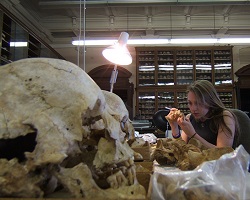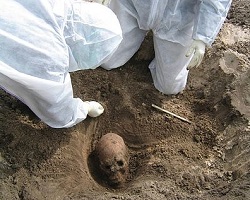
Being an Archaeologist
Why does Indiana Jane like being a bioarchaeologist? Because discovery is exciting. Some archaeologists travel to far-off lands to dig, but many work right in your home town. We need archaeologists everywhere, to protect the land and bones of our ancestors or the things that our ancestors left behind, known as artifacts.
Archaeologists have the power to explore. This is a big responsibility. Archaeologists need years of training and education. They learn how to respect ancient remains and protect them.
Archaeologists must get permission before digging or even picking up an artifact from the ground. The archaeology team’s job is to put together a giant puzzle, piecing together all of the things ancient people left behind. Much of this is now buried underground.

When the puzzle is complete, we learn fascinating stories about the way people lived.
Do you know what tools archaeologists use when exploring the past? Find out here.
Remember, if you see an artifact when hiking or exploring, the best thing to do is leave it behind. It is not only the law, but taking an artifact is like removing a piece of the archaeologist’s puzzle that will never be found, leaving holes in the story. Everyone has the power to help protect the past and the ancestors who lived before us.
Fully excavated skeleton via Wikimedia Commons by Hamed Saber.
Read more about: Indiana Jane: Uncovering Mysteries of Ancient Disease
Bibliographic details:
- Article: Being an Archaeologist
- Author(s): Dr. Biology
- Publisher: Arizona State University School of Life Sciences Ask A Biologist
- Site name: ASU - Ask A Biologist
- Date published:
- Date accessed:
- Link: https://askabiologist.asu.edu/being-archaeologist
APA Style
Dr. Biology. (). Being an Archaeologist. ASU - Ask A Biologist. Retrieved from https://askabiologist.asu.edu/being-archaeologist
Chicago Manual of Style
Dr. Biology. "Being an Archaeologist". ASU - Ask A Biologist. . https://askabiologist.asu.edu/being-archaeologist
Dr. Biology. "Being an Archaeologist". ASU - Ask A Biologist. . ASU - Ask A Biologist, Web. https://askabiologist.asu.edu/being-archaeologist
MLA 2017 Style

The position of a skeleton can tell archaeologists a lot, but they can learn even more if they can analyze the bones for marks and microbes.
Be Part of
Ask A Biologist
By volunteering, or simply sending us feedback on the site. Scientists, teachers, writers, illustrators, and translators are all important to the program. If you are interested in helping with the website we have a Volunteers page to get the process started.

